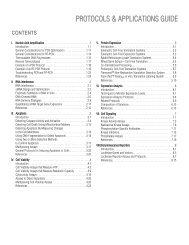Cloning Protocols and Applications Guide-A4 format - Promega
Cloning Protocols and Applications Guide-A4 format - Promega
Cloning Protocols and Applications Guide-A4 format - Promega
Create successful ePaper yourself
Turn your PDF publications into a flip-book with our unique Google optimized e-Paper software.
||||||||||||| 13<strong>Cloning</strong><br />
2. Add 5 units of T4 DNA Polymerase per microgram of<br />
DNA <strong>and</strong> 100µM of each dNTP.<br />
3. Incubate at 37°C for 5 minutes.<br />
Note: At high concentrations of dNTPs (100µM),<br />
degradation of the DNA will stop at duplex DNA;<br />
however, if the dNTP supply is exhausted, the very<br />
active exonuclease activity (200 times more active than<br />
that of DNA polymerase I) will degrade the<br />
double-str<strong>and</strong>ed DNA (Sambrook et al. 1989).<br />
4. Stop the reaction by heating at 75°C for 10 minutes or<br />
adding 2µl of 0.5M EDTA.<br />
C. Dephosphorylation of 5´ Ends<br />
If the ends of the prepared vector are identical (e.g.,<br />
following a single digestion), it is advantageous to treat the<br />
vector with TSAP Thermosensitive Alkaline Phosphatase<br />
(Cat.# M9910) to remove the phosphate groups from the 5′<br />
ends to prevent self-ligation of the vector (Sambrook et al.<br />
1989). For linear vectors with unique 5′ ends, TSAP<br />
treatment is not necessary.<br />
Note: Since TSAP is active in all <strong>Promega</strong> restriction<br />
enzyme buffers, the vector DNA easily can be restriction<br />
digested <strong>and</strong> dephosphorylated at the same time. The<br />
following protocol reflects this streamlined method. See<br />
the TSAP Thermosensitive Alkaline Phosphatase Product<br />
In<strong>format</strong>ion #9PIM991 for alternative protocols.<br />
1. As a general guideline, for reactions containing up to<br />
1µg of DNA, add 15 units of restriction enzyme <strong>and</strong><br />
the amount of TSAP listed below to the vector DNA in<br />
a total reaction volume of 20–50µl. Set up the reaction<br />
in the appropriate 1X <strong>Promega</strong> restriction enzyme<br />
reaction buffer.<br />
Reaction Buffer<br />
<strong>Promega</strong> 10X Reaction<br />
Buffers A–L (except F)<br />
<strong>Promega</strong> 10X Reaction Buffer<br />
F<br />
MULTI-CORE 10X Buffer<br />
Amount of TSAP<br />
for Reactions<br />
Containing ≤1µg<br />
DNA<br />
1µl<br />
2µl<br />
1µl<br />
2. Incubate the reaction at 37°C for 15 minutes. This is<br />
sufficient to digest <strong>and</strong> dephosphorylate all vector DNA<br />
overhang types (3´, 5´ or blunt).<br />
3. Heat-inactivate the TSAP <strong>and</strong> restriction enzyme by<br />
incubating the reaction at 74°C for 15 minutes.<br />
Note: Not all restriction enzymes can be<br />
heat-inactivated. If the restriction enzyme cannot be<br />
heat-inactivated, clean up the digest using the Wizard®<br />
SV Gel <strong>and</strong> PCR Clean-Up System (Cat.# A9281).<br />
4. Briefly centrifuge the reaction, <strong>and</strong> use approximately<br />
40ng of dephosphorylated vector in a ligation reaction<br />
containing DNA insert, 1X Rapid Ligation Buffer <strong>and</strong><br />
<strong>Protocols</strong> & <strong>Applications</strong> <strong>Guide</strong><br />
www.promega.com<br />
rev. 1/12<br />
2µl (6 units) of T4 DNA Ligase (LigaFast Rapid DNA<br />
Ligation Sytem, Cat.# M8221). Incubate ligation<br />
reactions containing vector with 5´ or 3´ overhangs at<br />
25°C for 5 minutes. Incubate ligation reactions<br />
containing vector with blunt ends at 25°C for<br />
15 minutes.<br />
Note: Optimal vector:insert ratios may need to be<br />
determined. We recommend using a 1:2 molar ratio of<br />
vector to insert DNA as a starting point. See the<br />
LigaFast Rapid DNA Ligation System Product<br />
In<strong>format</strong>ion #9PIM822 for additional in<strong>format</strong>ion.<br />
5. Transform the ligated material directly into E. coli<br />
competent cells following the recommended<br />
trans<strong>format</strong>ion protocol provided with the cells.<br />
VI. Composition of Solutions<br />
antibiotic stock solutions<br />
100mg/ml ampicillin in deionized water (sterile filtered)<br />
25mg/ml kanamycin; kanamycin sulfate in deionized<br />
water (sterile filtered)<br />
Store at –20°C.<br />
Blue/Orange 6X Loading Dye<br />
0.03% bromophenol blue<br />
0.03% xylene cyanol FF<br />
0.4% orange G<br />
15% Ficoll® 400<br />
10mM Tris-HCl (pH 7.5)<br />
50mM EDTA (pH 8.0)<br />
5X Flexi® Digest Buffer<br />
50mM Tris-HCl (pH 7.9 at 37°C)<br />
250mM NaCl<br />
50mM MgCl2<br />
5mM DTT<br />
0.5mg/ml acetylated BSA<br />
2X Flexi® Ligase Buffer<br />
60mM Tris-HCl (pH 7.8 at 25°C)<br />
20mM MgCl2<br />
20mM DTT<br />
2mM ATP<br />
Store in single-use aliquots at –20°C. Avoid multiple<br />
freeze-thaw cycles.<br />
IPTG stock solution (0.1M)<br />
1.2g isopropyl β-D-thiogalactopyranoside<br />
Add deionized water to 50ml final volume. Filter sterilize,<br />
<strong>and</strong> store at 4°C.<br />
LB medium<br />
10g Bacto®-tryptone<br />
5g Bacto®-yeast extract<br />
5g NaCl<br />
Add deionized water to approximately 1L. Adjust pH to<br />
7.5 with 10N NaOH, <strong>and</strong> autoclave. For LB plates, include<br />
15g agar prior to autoclaving.<br />
PROTOCOLS & APPLICATIONS GUIDE 13-20

















